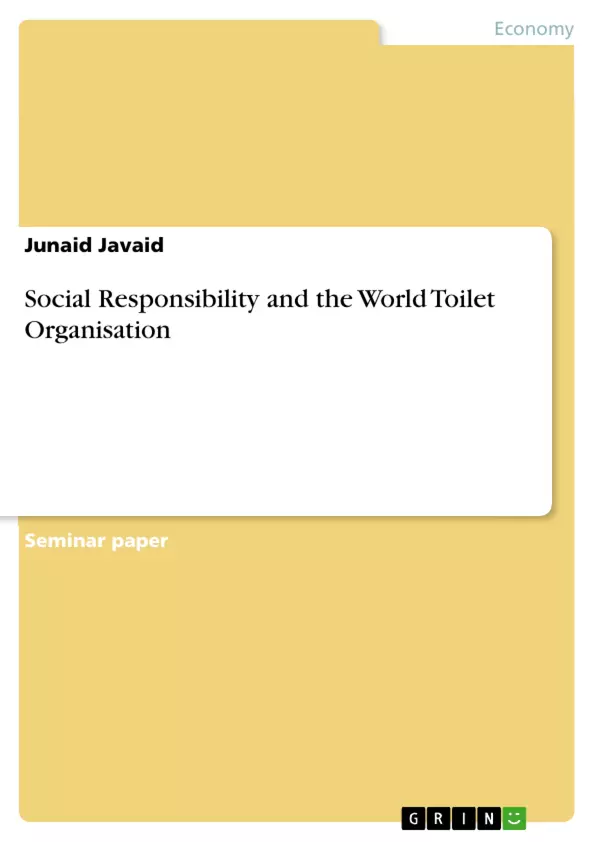The scope of this report is broad as it deals with implication of social responsibility in regard to the success of company. In relation to the Scale of Problems faced by World Toilet Organisation, it has been understood there is a huge underlying demand for the affordable solution as there are almost 2.6 billion people who does have access to proper sanitation and thus signifies that there is a desperate need for about one billion affordable toilets and hence rendering it as a significant work stream in the given context. The organisation only needed venture capital investment by 2015 and after that it would aim for massive scale. In accordance with model of self interest it has been outlined that Jack Sim (founder of World Toilet Organisation) oriented WTO as the advocacy organisation with the purpose of enhancing awareness of huge gap existing between the industrialised and emerging economies in the respective area. Correspondingly, WTO has started to involve heavily in the sanitation marketing and this have been made possible through SaniShop program (The World Economic Forum Water Initiative, 2011). It has been believed that in this way, WTO’s activities of business development can be tied up with the traditional communications, training activities and advocacy which has enhanced the organisation’s competence up to great extend throughout the whole decade operations. From the case study of Cadbury Schweppes, it has been discovered that the Community Investment Programme (CIP) is strategically helping the company to focus more on the resources where they could add value. Corresponding, in case of Grameen Group, With respect to TATA Group, the social activities have permitted the company to become most respected company in the history of Indian corporate sector. However, ASDA is able to clinch the success in the very short period as compare to its competitors and it is only possible through the social responsibility activities implicated by the company. And finally in reference to Toyota, the company’s strives toward promoting environmental and educational projected have directed the company towards the way of making its production processes more efficient and also have enhanced company’s reputation.
Inhaltsverzeichnis (Table of Contents)
- Chapter: 1- Aims & Objectives
- 1.1. Background Context
- 1.2. Problem Statement
- 1.3. Aim
- 1.4. Objectives
- Chapter: 2- Literature Review
- 2.1. What is Social Responsibility all about?
- 2.2. WTO's Scale of Problems
- 2.3. WTO's Model of Enlightened Self-Interest
- 2.3.1. Innovative Business Model for Social Impact
- Chapter: 3- Case Studies, Analysis & Discussion
- 3.1. Case Studies
- 3.1.1. Cadbury Schweppes
- 3.1.1.1. Company Profile
- 3.1.1.2. Social Responsibility Driver
- 3.1.1.3. Taking Action
- 3.1.1.4. Business Advantages
- 3.1.1.5. Company's Social Responsibility Strategy (Success/Unsuccessful)
- 3.1.2. Grameen Group
- 3.1.2.1. Company Profile
- 3.1.2.2. Grameen Phone
- 3.1.2.3. Grameen Veolia
- 3.1.2.4. Grameen Danore
- 3.1.2.5. Strategic Benefits
- 3.1.2.6. Company's Social Responsibility Strategy (Success/Unsuccessful)
- 3.1.3. TATA Group
- 3.1.3.1. Company Profile
- 3.1.3.2. TATA Group & Social Responsibility
- 3.1.3.3. TATA Steel
- 3.1.3.4. TATA Motors
- 3.1.3.5. Company's Social Responsibility Strategy (Success/Unsuccessful)
- 3.1.4. ASDA
- 3.1.4.1. ASDA & its Social Responsibility Measures
- 3.1.4.2. ASDA's Social Responsibility Strategy and its Benefits
- 3.1.4.3. Company's Social Responsibility Strategy (Success/Unsuccessful)
- 3.1.5. Toyota
- 3.1.5.1. Company Profile
- 3.1.5.2. Social Responsibility Practices
- 3.1.5.3. Company's Social Responsibility Strategy (Success/Unsuccessful)
- 3.2. Analysis
- 3.3. Discussion
- The importance of social responsibility in business
- The scale of the global sanitation problem
- The World Toilet Organisation's mission and approach
- Case studies of companies with successful social responsibility programs
- Analyzing the relationship between social responsibility and business success
Zielsetzung und Themenschwerpunkte (Objectives and Key Themes)
This report aims to examine the role of social responsibility in the success of companies, specifically focusing on the World Toilet Organisation (WTO). It explores the scale of the sanitation problem faced by the WTO and analyzes how its initiatives are driven by a model of enlightened self-interest. The report also delves into case studies of several companies to demonstrate how they have implemented social responsibility strategies.
Zusammenfassung der Kapitel (Chapter Summaries)
Chapter 1: Aims & Objectives introduces the concept of social enterprise and its focus on social responsibility. It outlines the background of the sanitation problem and highlights the need for affordable solutions, emphasizing the role of the World Toilet Organisation.
Chapter 2: Literature Review explores the concept of social responsibility in business and delves into the WTO's scale of problems, particularly the lack of access to proper sanitation for billions of people. It also examines WTO's model of enlightened self-interest and its innovative business model for social impact.
Chapter 3: Case Studies, Analysis & Discussion presents a series of case studies of companies known for their social responsibility initiatives, including Cadbury Schweppes, Grameen Group, TATA Group, ASDA, and Toyota. Each case study examines the company's profile, its social responsibility drivers, actions taken, business advantages, and an assessment of the success or failure of its social responsibility strategy.
Schlüsselwörter (Keywords)
Social responsibility, World Toilet Organisation, sanitation, business model, enlightened self-interest, social enterprise, case studies, Cadbury Schweppes, Grameen Group, TATA Group, ASDA, Toyota, business success, social impact, sanitation marketing, SaniShop program.
- Quote paper
- Junaid Javaid (Author), 2013, Social Responsibility and the World Toilet Organisation, Munich, GRIN Verlag, https://www.grin.com/document/282340



